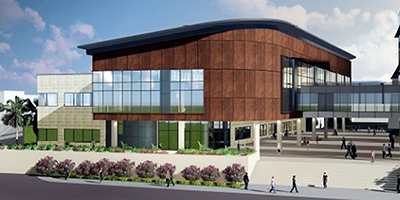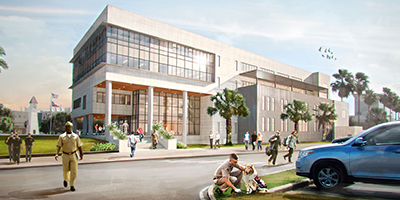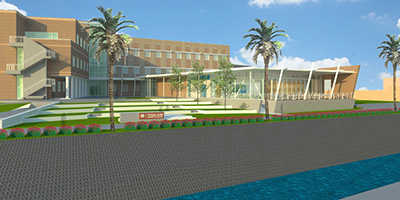The Texas A&M University at Galveston campus is experiencing unprecedented growth. Learn more about some of the projects just completed, underway or being developed.

Texas A&M Maritime Academy Hall
The Texas A&M Maritime Academy Hall was completed through a public private partnership (P3) with Hunt Development Companies. The building opened for occupancy in November 2015 and is the first significant building constructed on the north side of Seawolf Parkway. In addition to the building, an access road, parking, and appropriate lighting have been constructed. While the road provides vehicular access, more direct pedestrian access is available with a pedestrian walkway on the south side that connects the building to the rest of the campus residential community.
Safety is always a priority for the campus. In addition to appropriate lighting on the access road and around the building, the Texas A&M Maritime Academy Hall also uses card key access into the building, wings and suites. Safety of pedestrian traffic crossing Seawolf Parkway has been addressed using a unique solution known as a High intensity Activated crossWalK (HAWK). The HAWK is a pedestrian-activated beacon located on the roadside. For a brief introduction to the HAWK system, please click the link below for a YouTube video prepared by the Delaware Department of Transportation.
In addition to the student residences, the Texas A&M Maritime Academy Hall also includes a variety of lounge space, office space, four classrooms, a large laundry room and dining retail space operated by Chartwells. The dining retail space includes Seawolf Subs, a Starbucks "We Proudly Brew" coffee shop, an ice cream station and an Outtakes – all of which will be accessible with student meal plans.
 Academic Complex—Phase 1
Academic Complex—Phase 1
Phase 1, also referred to as the academic building, of the Academic Complex will move the campus forward in meeting a primary objective – vacating the Sea Aggie Center. While this phase will not provide space to relocate all operations from the Sea Aggie Center, Phase 1 will accommodate the interactive spaces and operations currently in the Sea Aggie Center, including the classrooms, laboratories, Enrollment Services, Research and Graduate Studies and the cashier.
Through a generous gift from the Abe and Annie Seibel Foundation, the campus will also be able to relocate the Office of Academic Enhancement, the Honors Program and Undergraduate Research Scholars into the new building and effectively build a new student learning center for the campus.
 Academic Complex—Phase 2
Academic Complex—Phase 2
Phase 2, also referred to as the large lecture facility/support services building, will total nearly 38,000 assignable square feet and will provide a striking addition to the “front door” of the campus and include large lecture space that can be subdivided into smaller lecture spaces, a number of seminar rooms, new space for the campus bookstore, mail services and copy center, and support space that will house Administration and Auxiliary Services, including Human Resources. A variety of architectural design features and material colors and textures will enhance the visual impression made as prospective students and faculty, families and other campus visitors arrive on campus.
Once complete, a visual portal will be created between the Phase1 and Phase 2 buildings to highlight the Bracewell Clock Tower and also create a walking mall that connects the front of campus with the quadrangle area. Plentiful glass is anticipated to enhance the appearance of the exterior as well as provide natural light to the interior.

Pavilion
The Pavilion will be located on the south side of the Oceans and Coastal Studies Building, between the building’s courtyard and the waterfront. The building will restore valuable waterfront event space that was lost during the reconstruction of the campus marina and will include a multipurpose room that will accommodate 150 people in banquet seating and nearly 275 people in theater seating. Unique to this new building will be its indoor/outdoor capability. Much of the glass exterior windows will be designed to fold which will extend the indoor space outdoors to an open air deck that will accommodate an additional 50-100 seats, depending on event setup.
In addition, the project will also include an outdoor amphitheater that can further extend the space of the pavilion, or also be used as a seperate venue for outdoor events.
Mariner Hall Demolition (C Dorm)
While Mariner Hall is not our oldest residence hall, the building certainly has been our most "tired" residence hall. Window air conditioning units, doors that open to the weather outside and a design that followed a (now) very old style national hotel brand, Mariner Hall has served its useful life. Opened in 1980 and known as "C Dorm" until the mid-2000s, Mariner Hall had space for 414 beds, an administrative area and a study room. Long used to house cadets in the Texas A&M Maritime Academy, Mariner Hall was recently scheduled for demolition when the new Texas A&M Maritime Academy Hall opened across Seawolf Parkway.
Mariner Hall/C Dorm evokes many memories to those who had the opportunity to live in one of its rooms or work in the administrative area. Until 2012 when Atlantic and Pacific Halls opened, many students preferred Mariner Hall simply due to the rooms being larger than those in Oceans and Hullaballoo Halls (A and B Dorm). Over the course of its life, Mariner Hall was home to Mail Services, Student Counseling, Financial Aid, Academic Enhancement, the Student Government Association, the campus yearbook and the Student Veterans Association.
While lots of inquiries were received about "pushing the button," the demolition of Mariner Hall will not be by implosion, but by through mechanical means. The work will be completed by a known national commercial demolition contractor.
 Infrastructure
Infrastructure
Texas A&M University at Galveston celebrated its 50th anniversary in 2012. Over the course of those first 50 years the campus has increased the number of buildings and other facilities to accommodate enrollment growth and campus expansion. While the above ground expansion has met the demand, our underground thermal, electrical and information technology loops have not kept up as well both in size and maintenance. Underground lines are subject to the poor soil conditions, temperature and wet/dry extremes. In addition to our underground lines, the campus continues to lag behind in firm capacity in our heating, ventilation and air conditioning systems. Finally, the campus wastewater treatment plant is aging and capacity needs to be increased.
The campus has a prioritized list of projects that will be completed as funding permits. The highest priority requires the total replacement of the wastewater treatment plant. The campus anticipates the new plant being relocated to the other side of Seawolf Parkway, thus removing the new plant from the approach to our front entrance. In addition to this project, the campus also anticipates completion of the following projects:
- Electrical and thermal distribution loops
- Information Technology loop
- Replacement of switchgear and transformer at physical plant building
- Air conditioning the existing central plant
- Tie-in air coiled chillers at academic complex into campus thermal loop
This article was originally published by Texas A&M University at Galveston.
Texas A&M Foundation
The Texas A&M Foundation is a nonprofit organization that solicits and manages investments in academics and leadership programs to enhance Texas A&M’s capability to be among the best universities.